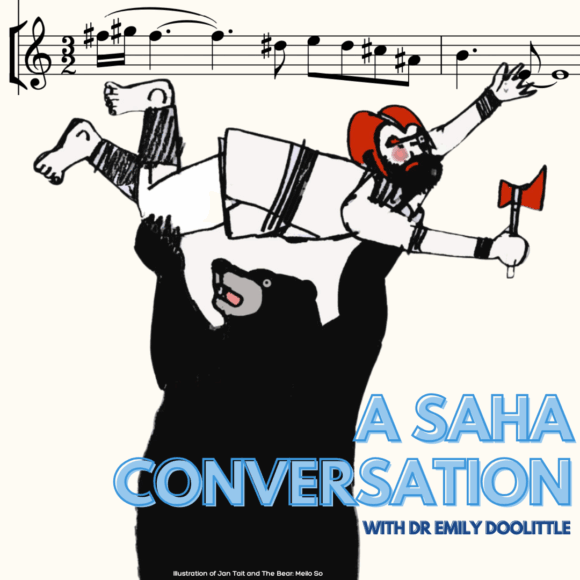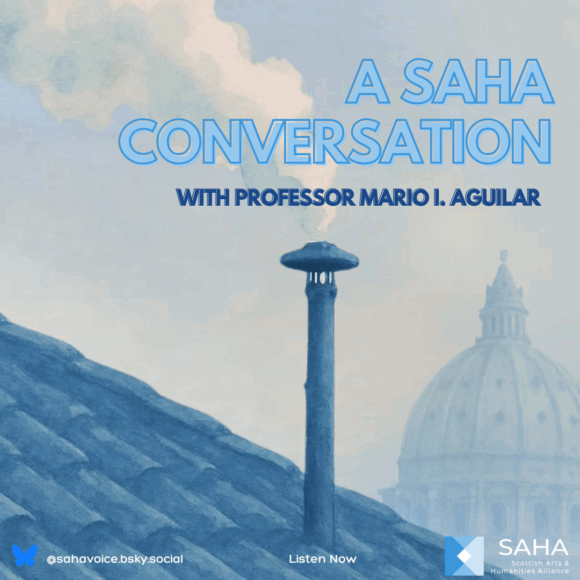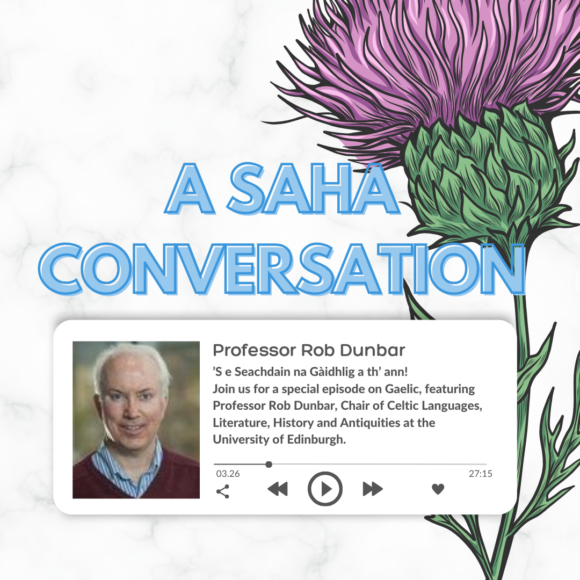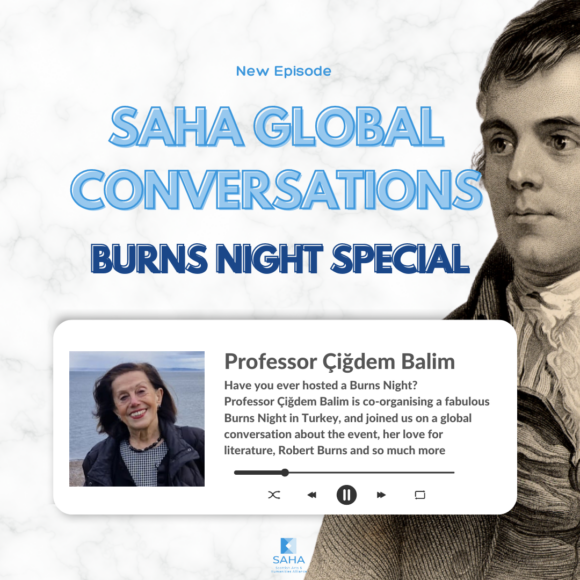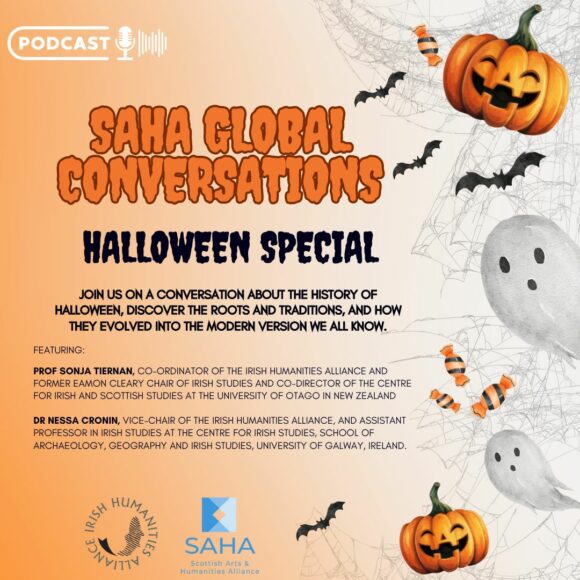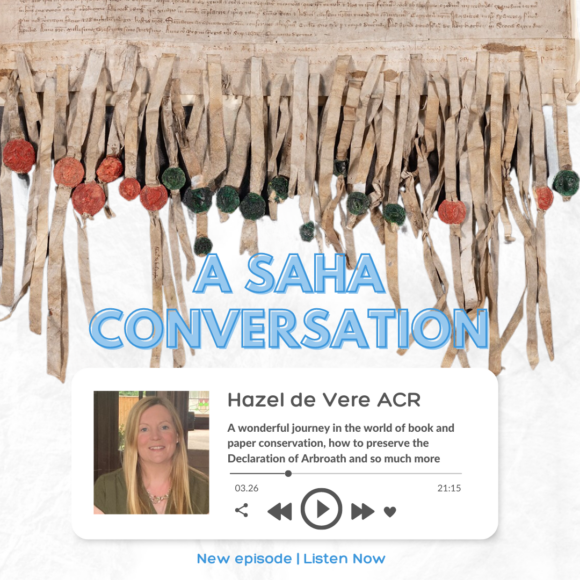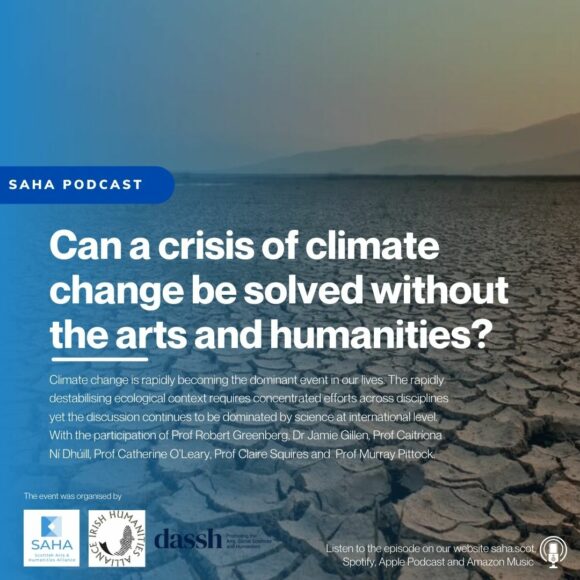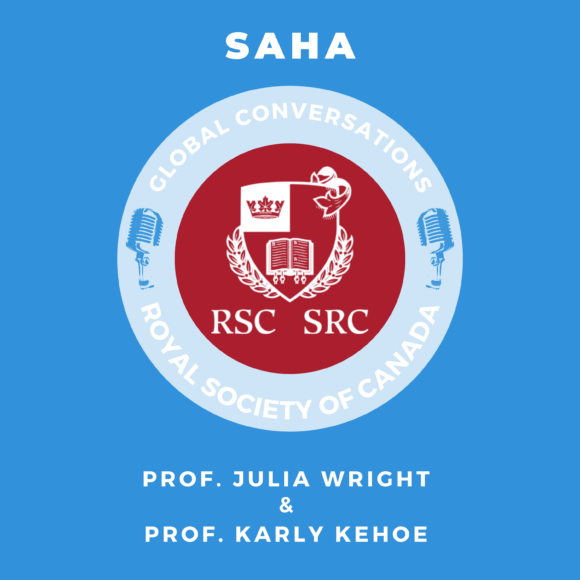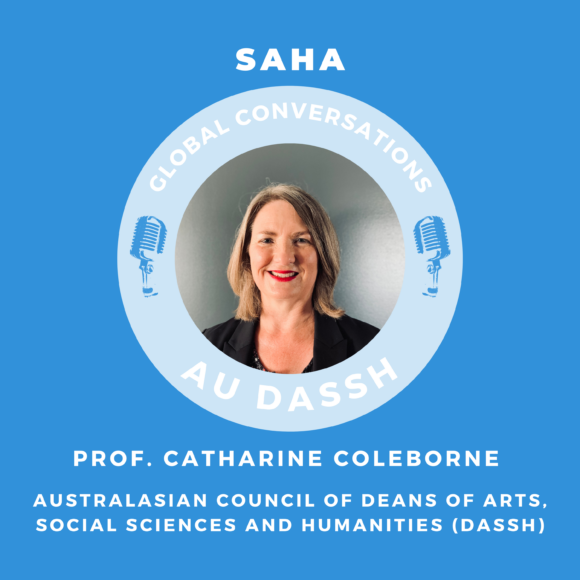Welcome to a new episode of A SAHA Conversation, a podcast by the Scottish Arts and Humanities Alliance.
In this episode, we will talk with Dr Lindsay Middleton, a food historian who will provide eye opening perspective on the history of food, historical sustainable practices and so much more.
Dr Middleton is a recent University of Glasgow PhD graduate, her research focused on the nineteenth century and examined the form and function of the most ubiquitous form of food writing: the recipe, and its ties with material cooking technologies. With formal analysis she reads the recipe as a form of literary technology: it has significant aesthetic qualities and practical aims, it reflects technological modifications in food and cooking, and it is shaped by the changing pace of print and publications. Her goal was to find new ways of understanding contemporary attitudes towards innovation and cultural preservation in the nineteenth century.
 Transcript
Transcript
Hello and welcome to a new episode of A SAHA Conversation, a podcast by the Scottish Arts and Humanities Alliance. SAHA brings together 15 higher education institutions, the Scottish Graduate School for Arts & Humanities, the Royal Society of Edinburgh and to promote the contribution of arts and humanities to society.
In this episode, we will talk with Dr Lindsay Middleton, a food historian who will provide eye opening perspective on the history of food, sustainable historical practices and so much more.
Dr. Middleton, thank you for joining us. We are delighted to have you on our SAHA Conversation podcast and congratulations on your PhD. So your research focuses on the 19th century food writing, the recipe and its ties with material cooking technologies. You read a recipe as a form of, literary technology. A recipe is a technological method or medium and its participation in the transformative process of cooking. That sounds fascinating. How did you fall in love with this topic and how was your PhD journey?
Thank you so much for the invitation to come and speak to you today and for the congratulations on my PhD. That was quite recent, so it’s still not quite sunk in yet, but really exciting. So, yeah, in my research, I basically, as you say, I look at recipes and cookbooks as forms of literary technology. And it was sort of a roundabout way that I got into this topic. My undergraduate, which I did at Glasgow, was in English literature, and then I did a Master’s in Victorian literature. And that was when I really fell in love with the 19th century as a time period. I just thought it was fascinating the sort of developments that went on in the period in terms of things like technology and innovation. And it was through literature rather than food that I really got into the period. So novels by writers like Dickens and Mary Elizabeth Braddon, but the food element really came into things because I’ve always just loved cooking and reading cookbooks as a sort of hobby. I came from a family of really excellent cooks, and I decided that I would love to be able to marry my interests in writing and food by applying a literary reading to things like recipes and cookbooks. So I started that in my undergraduate dissertation. I wrote about 20th century recipes as a narrative form and looked at some novels and representations of food and novels. Then in my Victorian literature Master’s, I looked at etiquette guides and how they sort of crossed over with realist fiction. And then in the PhD, I moved to more solidly looking at recipes and cookbooks. So it’s basically just been a sort of fusion of my passion for food and my craft as a literary reader, I suppose. Although now, throughout the PhD, I kind of moved into more cultural history, because I’m not looking at novels and poems, I’m looking at these sort of practical texts. And, yes, in terms of my PhD journey, it was wonderful. I absolutely loved it. I was really lucky to have an excellent team of supervisors. And it was such a passion project. I finished it loving it even more than I thought I would as I started, so I was really lucky in that respect.
Well, that is absolutely wonderful to hear. So it seems like your research is about sort of like fusion cuisine, fusion literary cuisine or something like that.
My work is very interdisciplinary in nature. I have one foot in literature and literary readings of things, but then another foot in the history of technology. So I approached food and the texts that write about food with a very sort of interdisciplinary mind, I suppose. So I was interested in how they function as pieces of literary writing. So I argue that recipes are not just sort of practical, instructive texts, but they’re actually operating in very literary ways. They’re written with very deliberate set of literary techniques. And if you analyse a recipe in the same way you would analyse a poem, you get some really fascinating things coming out of it. So that was really where the kind of fusion side comes into it, the way I approach these texts. And then what I did with that analysis was used my reading of these texts to kind of make wider conclusions about historical happenings in the 19th century. So things like industrialization and globalisation and gender roles, class presumptions, stuff like that. So I kind of start with the recipe and then build out words. And use that as a way into 19th century culture, I suppose.
Interesting. Well, I assume poetry and literature, just like food and food recipes, has certainly changed a lot since the 19th century. The diet, the way the food was sourced and produced. Of course, cooking methods as well. Quite a different word. So was the whole process more sustainable in the 19th century or is it just a myth?
It’s a really interesting question and there’s probably not a straightforward answer. I suppose the 19th century was, the way I see it, the time when our relationship to food really began to change. And there were many, many reasons for that that would be impossible to go into in this conversation. But primarily, and in a British context, the population of Britain in the 19th century rapidly expanded and grew very, very quickly. And that presented a big challenge, which was how do we, as a small country, feed everyone? People also moved increasingly away from the countryside and into the city as a way of because they needed to find jobs and employment and industrialization really sped that up because people began working in factories. And that meant that, not for the first time, but in a sort of more accelerated way, the gap between the food being produced and the person eating it really began to grow. And this is when, I think you could argue that there’s a turning point in the way that food is produced around the world and transported around the world. So in many ways, some of the food production practises yes. Would have been far more sustainable than they are today because the farming methods were less invasive, although that was changing. There wasn’t the same kind of mass production of food or use of things like pesticides. But the 19th century is really when that begins to shift and we have things like the introduction of tinned foods, which changed how food was moved all over the world to feed different populations or to feed people who were travelling and expanding the empire. And that was a very industrialised food process. That was the sort of beginning of mass production in a way that ends up not being sustainable. So I think if you’re living in the countryside in the 19th century and you’re wealthy and you’re lucky enough to have a kitchen garden, in that way, food production was more sustainable. But it was beginning to move away because of the number of people needing fed and the way that food had to be changed in order to feed them. So food basically grew and changed the way. That we see food, the way that we consume food has changed due to industrialization and globalisation, is that what you’re saying? Yes, absolutely. So it could be. Things like tinned fruit is a really good example because, for example, the process was it originated in Britain, but it very quickly disseminated across the rest of the world and it was brought to places like Australia and South America. Where there were big stalks of cattle and sheep and the meat would be tinned there and then brought back to Britain in order to feed the population. So that’s like a big journey for food to go. At the same time, tins of food are being put on ships for sailors, the Navy explorers who are travelling the world and expanding it. And this was before things like refrigeration, which was also introduced sort of end of the 19th century. Beginning of the 20th century. But, yes, it was globalisation and the kind of acceleration of globalisation through industrialization that really changed things in the sort of beginning of how things look now.
This was also before the fast travelling methods, so everything was, I want to say, distributed by cargo ships. So it would take months to arrive from destination, is that correct?
Yes, exactly. And there are big developments in we have things like the steamship which come come into play in the 19th century and that really changed things like refrigeration as well. But you’re right, it would have taken a long time for things to get from A to B. So that’s why I think processes like tinning food were preferable to the older processes which had been around for hundreds of years, like salting meat or potting meat or drying things out just because it kept food in a slightly better condition and it was less vulnerable to perils of long ship voyages, saying that for hundreds of years before the 19th century, very exotic ingredients were being brought to Britain on ships. And these developments in the 19th century just sort of sped that up.
So you could have had an avocado on toast in the 19th century for breakfast?
I’ve not come across any references to avocados interestingly, but there are lots of things like pineapple. I find really interesting examples of tinned foods that were marketed at luxury retailers, which were like tinned green turtle fat for making your turtle soup. So these quite luxurious, definitely non native British ingredients were being brought to Britain to be enjoyed by those who had the money to afford them. So not quite avocado to us, but there were certainly some fairly, you know non native and interesting foods being eaten, for sure.
Maybe a pineapple cake or something like that.
Lots of pineapples fruits is a big one. Fruits and vegetables and meats. Pineapples by this point were still fairly rare, but not as rare as you would think.
So what can we learn from the past and apply it to present day?
It’s a really interesting question and I think one of the things that, as a historian, I find fascinating is the the issues that are being discussed in texts around food in the 19th century things like feeding the population, nutrition, the best kinds of diet for healthy bodies and healthy minds these are conversations that we’re still having and they were really worrying people in the 19th century. And I think in recent years, we’ve gone through things like the pandemic, we’ve gone through things like we’re going through wars that are problematizing food chains and climate change. All these issues are really showing how fragile our food chains are and the dangers of relying upon being able to source food from the rest of the world, whether that turns into fairly harmless shortages, like the recent shortage of tomatoes in British supermarkets, or far bigger issues. I think what these discussions had in the past can really help us to realise is that actually, these problems are very long standing, but they have been amplified in recent years and they really demonstrate the value of being able to produce food in a far more local, sustainable way. Because relying on food from the rest of the world, or having the expectation that we should get tomatoes all year round, or pineapples all year round, or fruit and vegetables in the supermarkets that’s grown overseas, is not a sustainable thing to do. So returning to some of the more traditional heritage practises of producing food, that befits the environment that we live in and that can be sourced locally, it would be a really valuable thing to do. It’s not to say it’s an easy thing to do, it’s an incredibly difficult thing to do, but something that increasingly, I think, we’re going to have to think of going forward.
Well, speaking of sustainable food, june 18 is World Sustainable Gastronomy Day. So let’s talk Scottish food. Perhaps one of the most famous food rituals, if we can call it like that, would be Burns Night with the traditional Burns Supper. So, I am told that the centrepiece of any good Burn Supper is haggis. But what about the rest of the menu?
So, yeah, Burns Supper is a really interesting thing in the context of Scottish food, because I think, as you say, one of the first things you think of when you think Scottish food is haggis. And I’m Scottish, I’ve lived in Scotland for most of my life and I think with very few exceptions, I probably only eat haggis on Burns Night. It’s not something that is part of my day to day diet, but it’s a very good example of how traditional food can be tied to literary history and Scottish iconography and can do really well as a sort of tourist export. I suppose. In terms of the rest of the menu, the traditional accompaniments for haggis would be neeps and tatties, so mashed turnip or swede and potatoes. And it’s really that sort of trio that is the traditional Burns Supper, in fact, the traditional way of eating haggis. Of course, now you get all sorts of weird and wonderful ways of eating haggis, from Haggis bon bons bonds to haggis pakora and I remember seeing a haggis burrito recently, so it’s definitely been adapted as an ingredient and integrated into our wonderfully international Scottish cuisine. But, yes, Burns would have been eating haggis, neeps and tatties. And I don’t think that’s really changed much in terms of the Burns Supper from what he would be eating back in the day. Maybe a whiskey sauce, if you were lucky.
So could we call this a sustainable supper, then? Local sustainable food?
You could, I suppose. And and haggis is actually a really interesting example of this, because I find, as a food historian, I find haggis to be very interesting. The fact that it’s become this kind of paragon of Scottish diet is fascinating because almost every culture around the world has a haggis equivalent. So for those listening who may not know, haggis is basically an offal pudding, or sausage, which is made with oatmeal, is the kind of main constituent that’s what bulks it up. And then it’s things like the intestines of the animal, all the kind of offcuts of meat, and it would be typically sheep and perhaps pork. They would be sort of cut up, combined with the oatmeal packed into an intestine, or like the stomach lining of an animal and then boiled and it becomes this pudding. And that’s really a food for poor people because a haggis or a black pudding or an andouillette, if you’re in France, they are kind of the sausage that you make with all the bits that are left of the animal when the good stuff has been bought by people with more money. So in that sense, haggis is you could argue haggis was sustainable because you’re using it the kind of nose to tail approach to cooking. You’re using everything from the animal. And I think if you’re going to eat meat, that’s a really valuable attitude to have because these things shouldn’t go to waste. And if we can make them into delicious foods, then we should.
So from now on, every January, when I will do my Burns Supper, I will clarify that it’s a sustainable meal. That’s very good to know. It will be a fun fact and I’m sure the listeners will be able to sell this fact that their own Burns Suppers as well. Before we leave, do you have one special tip from the 19th century that can help us in the present day and make our food habits more sustainable? Except for eating haggis, of course.
Yes, except for eating haggis. I think the main thing would be to eat seasonally. And in my research again, I kind of see this shifting, you see in recipes for things like tinned foods or adverts for things like preserved foods, that the wonder of these new food technologies is that the British housewife would be able to cook she’ll have ingredients to hand at any time of the year. So that’s where we begin to see that shift away from seasonal eating. But I believe that eating seasonally is one of the best things that we can do in order to eat in a sustainable manner. So eating things at the appropriate time of year, not only does it mean that things hopefully will have to travel less and may even be able to be grown in Scotland, but also the food is actually nicer, it tastes better. Things like fruit and vegetables, if you eat them in the appropriate season, rather than eating tomatoes in the dead of winter, the tomato is going to taste better in summer when it’s seasonally appropriate. And then the other thing that you can do to kind of counteract that we’re very used to in this country and in the Western world, eating whatever we want at any time of year. If you want to eat things like tomatoes in winter, you can preserve them. There are all sorts of preservation methods that have been around for hundreds of years and you see them in 19th century cookbooks and in earlier cookbooks. Things like pickling or what the Americans would call canning fruit making jams, chutneys. I think that’s a really useful thing that we can do that people living in 19th century Scotland would have been very used to doing. They weren’t used to getting vegetables or fruits at all time of year. So in the summer, with excess crops, they would turn them into things, put them in jars that would last them all through the winter. And eating seasonally is definitely a good move towards both local food and sustainable food.
That is very interesting, and I hope our listeners have taken notes about this. I certainly have. Thank you very much, Dr. Middleton, for taking part to our podcast series. And once again, congratulations for your PhD.
Thank you so much for having me on. It’s been a joy to talk to you today.
Thank you for listening to our SAHA conversation with Dr. Lindsay Middleton. If you enjoyed this episode, please share it and follow us on Twitter and Instagram at SAHA_Voice and on Facebook at Scottish Arts and Humanities Alliance.
